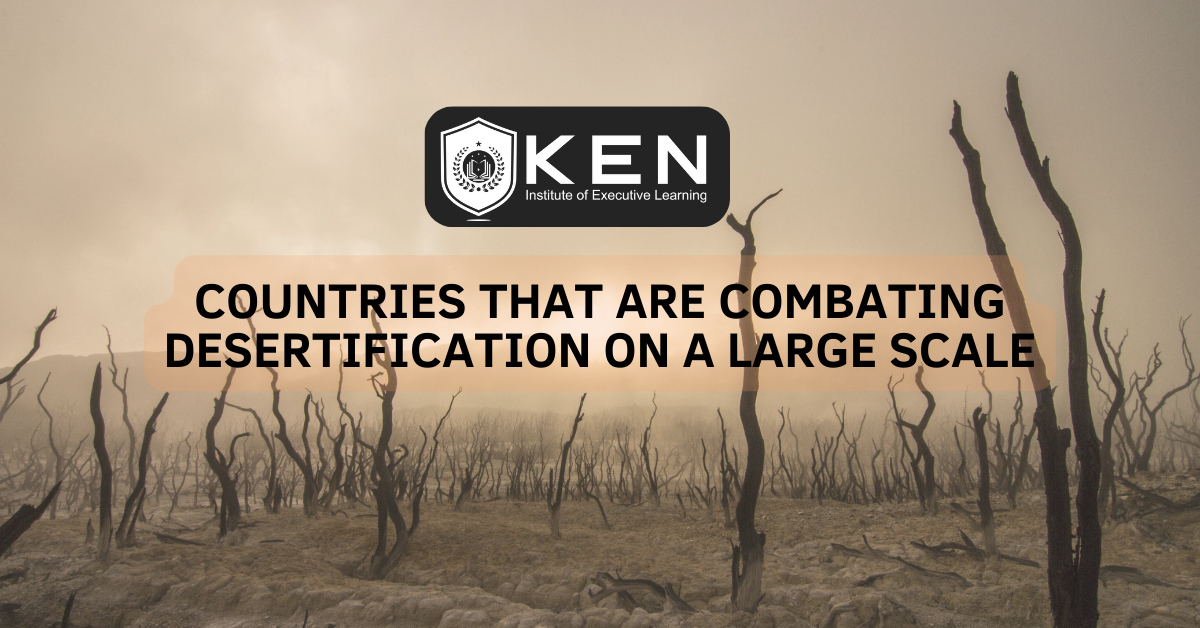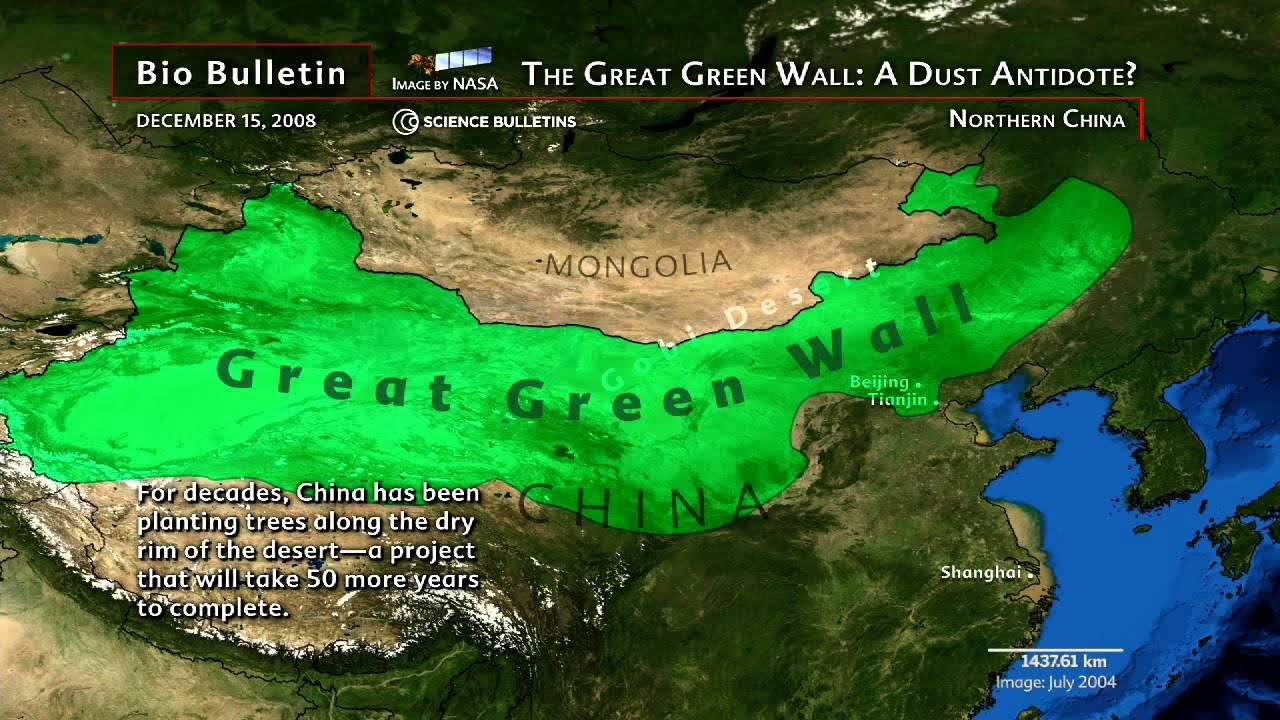
“Combating Desertification” is a critical global challenge, as arable land is lost to desertification at an alarming rate, affecting the livelihoods of millions of people. Several countries are actively engaged in Combating Desertification through various initiatives and sustainable land management practices.
Here are some countries that are making significant efforts to combat desertification:
China:
China has implemented the “Great Green Wall” project, aiming to plant a vast belt of trees and shrubs along the northern edge of the Gobi Desert to prevent its expansion. Afforestation and reforestation programs are being undertaken to combat soil erosion and desertification in various regions.

Great Green Wall Project: Launched in 1978, this project aims to create a green belt across the northern part of China to combat desertification. The project involves planting trees, shrubs, and grass to prevent soil erosion and halt the expansion of the Gobi Desert.
Afforestation and Reforestation: China is investing heavily in afforestation and reforestation programs, focusing on converting barren lands into productive forests for Combating Desertification. This helps in stabilizing soil, preventing sandstorms, and improving overall environmental quality.
Ecological Migration Programs: China has implemented large-scale ecological migration programs, relocating communities from ecologically fragile areas to more sustainable locations. This helps in reducing human pressure on vulnerable ecosystems.
Grain for Green Program: Launched in 1999, this program incentivizes farmers to convert sloping or barren farmland into forested areas or grasslands. Farmers receive subsidies or grain allowances in exchange for participating in afforestation efforts.
Sand Control Measures: China has invested in engineering solutions for sand control, including the construction of sand barriers, windbreaks, and vegetation belts. These measures aim to prevent the encroachment of dunes into productive land.
India:
India launched the National Mission for a Green India, which focuses on afforestation, reforestation, and improving biodiversity to combat desertification. Watershed management projects, like the Watershed Development Program, aim to enhance water availability and prevent soil erosion.
National Mission for a Green India: Launched under the National Action Plan on Climate Change, this mission focuses on afforestation, reforestation, and biodiversity conservation. Watershed management programs are crucial components, helping in soil moisture conservation and preventing land degradation.

Watershed Development Program: Implemented across various states, this program focuses on enhancing water availability through techniques like check dams, contour bunding, and afforestation.
Social Forestry and Joint Forest Management: India has promoted social forestry, involving local communities in the management and protection of forests. Joint Forest Management (JFM) initiatives empower communities to actively participate in afforestation and forest conservation.
National Rural Employment Guarantee Act (NREGA): NREGA includes provisions for water conservation and land development activities. It employs rural households while simultaneously addressing issues related to soil erosion and water scarcity.
Integrated Watershed Management: Various states in India have implemented Integrated Watershed Management Programs, incorporating measures like contour trenching, check dams, and afforestation to enhance water availability and prevent soil erosion.
Ethiopia:
Ethiopia is actively involved in the African Forest Landscape Restoration Initiative for Combating Desertification, with a goal to restore 15 million hectares of degraded land by 2030. The country has implemented sustainable land management practices, including terracing, agroforestry, and community-based conservation initiatives.
African Forest Landscape Restoration Initiative: Ethiopia is actively involved in this continent-wide initiative, committing to restore 15 million hectares of degraded land by 2030. This involves community-based efforts and sustainable land management practices.
Farmer-Managed Natural Regeneration (FMNR): This innovative approach involves farmers protecting and managing the regeneration of trees on their land, contributing to increased vegetation cover and combating desertification.

Community-Based Afforestation: Ethiopia’s afforestation efforts often involve local communities. Communities are engaged in planting and caring for trees, ensuring a sense of ownership and sustainable management.
Green Schools Program: Ethiopia has initiated the Green Schools Program, where schools actively participate in tree planting and environmental conservation activities. This not only contributes to combating desertification but also raises awareness among the younger generation.
Restoration of Degraded Lands: Ethiopia focuses on restoring degraded lands through various practices, including agroforestry, sustainable land management, and reforestation initiatives.
Niger:
Niger has been successful in implementing farmer-managed natural regeneration (FMNR), an approach where farmers protect and manage the regeneration of trees on their land. The “Maradi Integrated Development Project” focuses on sustainable land management practices to combat desertification.
Maradi Integrated Development Project: This project focuses on sustainable land management practices, including water harvesting, agroforestry, and soil conservation. It aims to improve agricultural productivity and enhance the resilience of communities to climate change.
Community-Based Conservation Initiatives: Niger emphasizes the active involvement of local communities in the conservation and sustainable management of natural resources.

FMNR Extension: Farmer-Managed Natural Regeneration (FMNR) has been extended to various regions, allowing farmers to manage the spontaneous regeneration of trees on their land. This approach contributes to increased vegetation cover and improved soil fertility.
Sustainable Agricultural Practices: Niger promotes sustainable agricultural practices such as contour plowing, agroforestry, and water harvesting techniques to enhance agricultural productivity and prevent land degradation.
United Arab Emirates (UAE):
The UAE has launched the “Greening the Desert” initiative, which involves planting native vegetation and implementing sustainable agriculture practices in arid areas. Innovation, such as using treated wastewater for irrigation and developing drought-resistant crops, is part of their strategy to Combat Desertification.
Greening the Desert Initiative: Launched in the UAE, this initiative involves planting native vegetation in arid areas. The country has also invested in researching and developing drought-resistant crops suitable for the region.

Innovative Water Use: The UAE employs innovative practices such as using treated wastewater for irrigation, reducing the pressure on freshwater resources.
Research and Innovation: The UAE invests in research and innovation for desert agriculture. This includes developing crops that can thrive in arid conditions, using advanced irrigation technologies, and exploring sustainable farming practices.
Preservation of Indigenous Flora: Conservation efforts extend to preserving and restoring indigenous plant species adapted to the harsh desert environment. This helps maintain biodiversity and supports ecosystem resilience.
Australia:
Australia faces challenges with desertification in some regions, particularly due to land degradation. Various initiatives focus on sustainable agriculture and land management practices to combat soil erosion and degradation.
Sustainable Agriculture Practices: Australia faces challenges with land degradation in certain regions. Sustainable agriculture practices, including precision farming, minimum tillage, and the use of cover crops, are implemented to prevent soil erosion and improve land quality.
Landcare Programs: Australia’s Landcare programs involve community-driven initiatives for sustainable land management. These programs focus on activities like reforestation, soil conservation, and water management.

Innovative Agricultural Practices: Precision farming, conservation tillage, and the use of cover crops are adopted to improve soil health, reduce erosion, and enhance the overall sustainability of agricultural practices.
United States:
The U.S. has implemented programs like the Conservation Reserve Program (CRP) to encourage farmers to convert environmentally sensitive agricultural land to conservation areas, preventing soil erosion.
Conservation Reserve Program (CRP): The CRP encourages farmers to convert environmentally sensitive agricultural land into conservation areas. This helps in preventing soil erosion, improving water quality, and enhancing wildlife habitat.
Conservation Stewardship Program (CSP): The CSP in the United States encourages farmers to adopt conservation practices that address issues such as soil erosion, water quality, and wildlife habitat conservation.

Research and Development: The U.S. invests in research and development to find innovative solutions for sustainable agriculture, including soil conservation methods and technologies.
Brazil:
Brazil has implemented the National Action Plan to Combat Desertification and Mitigate the Effects of Drought, which includes measures to promote sustainable land management and restore degraded areas.
National Action Plan to Combat Desertification: Brazil’s action plan includes measures to promote sustainable land management, reforestation, and the restoration of degraded areas.

Community Engagement: Involving local communities in sustainable land management practices is a key aspect of Brazil’s strategy to combat desertification.
Agroforestry Systems: Brazil promotes agroforestry systems, integrating trees and shrubs with crops. This helps in preventing soil erosion, improving soil fertility, and promoting sustainable land use.
Collaboration with Indigenous Communities: Collaboration with indigenous communities is a key aspect of Brazil’s approach to sustainable land management. Indigenous knowledge and practices are integrated into conservation efforts.
Summary
These countries demonstrate a variety of approaches, from large-scale afforestation projects to community-based initiatives, all aimed at combating desertification. These diverse and multifaceted approaches, emphasize community involvement, sustainable land management, and the integration of innovative technologies. The combination of these strategies contributes to a more comprehensive and effective response to the challenges posed by desertification.
Join Ken Institute and unlock a world of online courses in Environment and Sustainability, Mechanical Engineering, Occupational Health and Safety, and Fire Safety. Take advantage of the expert faculty’s vast research experience and the flexibility of 100% online learning.
Get in touch with us At: info@keninstitute.com
Visit our website www.keneducation.in
Schedule a call with one of our advisors today on: +917569034271
Let’s connect on Facebook, YouTube, LinkedIn, and Instagram.

